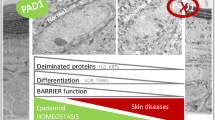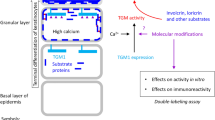Abstract
Mutations in SPINK5, encoding the serine protease inhibitor LEKTI, cause Netherton syndrome, a severe autosomal recessive genodermatosis. Spink5−/− mice faithfully replicate key features of Netherton syndrome, including altered desquamation, impaired keratinization, hair malformation and a skin barrier defect. LEKTI deficiency causes abnormal desmosome cleavage in the upper granular layer through degradation of desmoglein 1 due to stratum corneum tryptic enzyme and stratum corneum chymotryptic enzyme–like hyperactivity. This leads to defective stratum corneum adhesion and resultant loss of skin barrier function. Profilaggrin processing is increased and implicates LEKTI in the cornification process. This work identifies LEKTI as a key regulator of epidermal protease activity and degradation of desmoglein 1 as the primary pathogenic event in Netherton syndrome.
This is a preview of subscription content, access via your institution
Access options
Subscribe to this journal
Receive 12 print issues and online access
$209.00 per year
only $17.42 per issue
Buy this article
- Purchase on Springer Link
- Instant access to full article PDF
Prices may be subject to local taxes which are calculated during checkout








Similar content being viewed by others
References
Comel, M. Ichtyosis Linearis circumflexa. Dermatologica 98, 133–136 (1949).
Netherton, E.W. A unique case of Trichorrexis Invaginata. Arch. Dermatol. 78, 483–487 (1958).
Traupe, H. The Ichthyosis: A Guide to Clinical Diagnosis, Genetic Counselling, and Therapy (Springer-Verlag, Berlin Heidelberg, 1989).
Hausser, I. & Anton-Lamprecht, I. Severe congenital generalized exfoliative erythroderma in newborns and infants: a possible sign of Netherton syndrome. Pediatr. Dermatol. 13, 183–199 (1996).
Judge, M.R., Morgan, G. & Harper, J.I. A clinical and immunological study of Netherton's syndrome. Br. J. Dermatol. 131, 615–621 (1994).
Smith, D.L., Smith, J.G., Wong, S.W. & deShazo, R.D. Netherton's syndrome. Br. J. Dermatol. 133, 153–154 (1995).
Van Gysel, D. et al. Clinico-immunological heterogeneity in Comel-Netherton syndrome. Dermatology 202, 99–107 (2001).
Elias, P.M. & Menon, G.K. Structural and lipid biochemical correlates of the epidermal permeability barrier. Adv. Lipid Res. 24, 1–26 (1991).
Suzuki, Y., Nomura, J., Koyama, J. & Horii, I. The role of proteases in stratum corneum: involvement in stratum corneum desquamation. Arch. Dermatol. Res. 286, 249–253 (1994).
Fartasch, M., Williams, M.L. & Elias, P.M. Altered lamellar body secretion and stratum corneum membrane structure in Netherton syndrome. Arch. Dermatol. 135, 823–832 (1999).
De Wolf, K. et al. Netherton's syndrome: a severe neonatal disease. A case report. Dermatology 192, 400–402 (1996).
Scheimberg, I., Harper, J.I., Malone, M. & Lake, B.D. Inherited ichthyoses: a review of the histology of the skin. Pediatr. Pathol. Lab. Med. 16, 359–378 (1996).
Chavanas, S. et al. Mutations in SPINK5, encoding a serine protease inhibitor, cause Netherton syndrome. Nat. Genet. 25, 141–142 (2000).
Bitoun, E. et al. Netherton syndrome: disease expression and spectrum of SPINK5 mutations in 21 families. J. Invest. Dermatol. 118, 352–361 (2002).
Sprecher, E. et al. The spectrum of pathogenic mutations in SPINK5 in 19 families with Netherton syndrome: implications for mutation detection and first case of prenatal diagnosis. J. Invest. Dermatol. 117, 179–187 (2001).
Magert, H.J. et al. LEKTI, a novel 15-domain type of human serine proteinase inhibitor. J. Biol. Chem. 274, 21499–21502 (1999).
Bitoun, E. et al. LEKTI proteolytic processing in human primary keratinocytes, tissue distribution and defective expression in Netherton syndrome. Hum. Mol. Genet. 12, 2417–2430 (2003).
Mitsudo, K. et al. Inhibition of serine proteinases plasmin, trypsin, subtilisin A, cathepsin G, and elastase by LEKTI: a kinetic analysis. Biochemistry 42, 3874–3881 (2003).
Jayakumar, A. et al. Expression of LEKTI domains 6-9′ in the baculovirus expression system: recombinant LEKTI domains 6-9′ inhibit trypsin and subtilisin A. Protein Expr. Purif. 35, 93–101 (2004).
Komatsu, N. et al. Elevated stratum corneum hydrolytic activity in Netherton syndrome suggests an inhibitory regulation of desquamation by SPINK5-derived peptides. J. Invest. Dermatol. 118, 436–443 (2002).
Raghunath, M. et al. SPINK5 and Netherton syndrome: novel mutations, demonstration of missing LEKTI, and differential expression of transglutaminases. J. Invest. Dermatol. 123, 474–483 (2004).
Hardman, M.J., Sisi, P., Banbury, D.N. & Byrne, C. Patterned acquisition of skin barrier function during development. Development 125, 1541–1552 (1998).
Ekholm, I.E., Brattsand, M. & Egelrud, T. Stratum corneum tryptic enzyme in normal epidermis: a missing link in the desquamation process? J. Invest. Dermatol. 114, 56–63 (2000).
Franzke, C.W., Baici, A., Bartels, J., Christophers, E. & Wiedow, O. Antileukoprotease inhibits stratum corneum chymotryptic enzyme. Evidence for a regulative function in desquamation. J. Biol. Chem. 271, 21886–21890 (1996).
Pulkkinen, L., Choi, Y.W., Kljuic, A., Uitto, J. & Mahoney, M.G. Novel member of the mouse desmoglein gene family: Dsg1-beta. Exp. Dermatol. 12, 11–19 (2003).
Kljuic, A. & Christiano, A.M. A novel mouse desmosomal cadherin family member, desmoglein 1 gamma. Exp. Dermatol. 12, 20–29 (2003).
Ishida-Yamamoto, A. et al. LEKTI is localized in lamellar granules, separated from KLK5 and KLK7, and is secreted in the extracellular spaces of the superficial stratum granulosum. J. Invest. Dermatol. (in the press).
Hansson, L. et al. Cloning, expression, and characterization of stratum corneum chymotryptic enzyme. A skin-specific human serine proteinase. J. Biol. Chem. 269, 19420–19426 (1994).
Brattsand, M. & Egelrud, T. Purification, molecular cloning, and expression of a human stratum corneum trypsin-like serine protease with possible function in desquamation. J. Biol. Chem. 274, 30033–30040 (1999).
Caubet, C. et al. Degradation of corneodesmosome proteins by two serine proteases of the kallikrein family, SCTE/KLK5/hK5 and SCCE/KLK7/hK7. J. Invest. Dermatol. 122, 1235–1244 (2004).
Magert, H.J. et al. The 15-domain serine proteinase inhibitor LEKTI: biochemical properties, genomic organization, and pathophysiological role. Eur. J. Med. Res. 7, 49–56 (2002).
Magert, H.J. et al. LEKTI: a multidomain serine proteinase inhibitor with pathophysiological relevance. Int. J. Biochem. Cell Biol. 34, 573–576 (2002).
Kreutzmann, P., Schulz, A., Standker, L., Forssmann, W.G. & Magert, H.J. Recombinant production, purification and biochemical characterization of domain 6 of LEKTI: a temporary Kazal-type-related serine proteinase inhibitor. J. Chromatogr. B Analyt. Technol. Biomed. Life Sci. 803, 75–81 (2004).
Amagai, M., Matsuyoshi, N., Wang, Z.H., Andl, C. & Stanley, J.R. Toxin in bullous impetigo and staphylococcal scalded-skin syndrome targets desmoglein 1. Nat. Med. 6, 1275–1277 (2000).
Ding, X., Diaz, L.A., Fairley, J.A., Giudice, G.J. & Liu, Z. The anti-desmoglein 1 autoantibodies in pemphigus vulgaris sera are pathogenic. J. Invest. Dermatol. 112, 739–743 (1999).
Vasioukhin, V., Bowers, E., Bauer, C., Degenstein, L. & Fuchs, E. Desmoplakin is essential in epidermal sheet formation. Nat. Cell Biol. 3, 1076–1085 (2001).
Simon, M., Montezin, M., Guerrin, M., Durieux, J.J. & Serre, G. Characterization and purification of human corneodesmosin, an epidermal basic glycoprotein associated with corneocyte-specific modified desmosomes. J. Biol. Chem. 272, 31770–31776 (1997).
Levy-Nissenbaum, E. et al. Hypotrichosis simplex of the scalp is associated with nonsense mutations in CDSN encoding corneodesmosin. Nat. Genet. 34, 151–153 (2003).
Yang, T. et al. Epidermal detachment, desmosomal dissociation, and destabilization of corneodesmosin in Spink5−/− mice. Genes Dev. 18, 2354–2358 (2004).
Elias, P.M. The epidermal permeability barrier: from the early days at Harvard to emerging concepts. J. Invest. Dermatol. 122, vi–ix (2004).
Kuramoto, N. et al. Development of ichthyosiform skin compensates for defective permeability barrier function in mice lacking transglutaminase 1. J. Clin. Invest. 109, 243–250 (2002).
Furuse, M. et al. Claudin-based tight junctions are crucial for the mammalian epidermal barrier: a lesson from claudin-1-deficient mice. J. Cell Biol. 156, 1099–1111 (2002).
Segre, J.A., Bauer, C. & Fuchs, E. Klf4 is a transcription factor required for establishing the barrier function of the skin. Nat. Genet. 22, 356–360 (1999).
List, K. et al. Loss of proteolytically processed filaggrin caused by epidermal deletion of Matriptase/MT-SP1. J. Cell Biol. 163, 901–910 (2003).
Bernard, B.A. Hair shape of curly hair. J. Am. Acad. Dermatol. 48, S120–S126 (2003).
Stevanovic, D.V. Multiple defects of the hair shaft in Netherton's disease. Association with ichthyosis linearis circumflexa. Br. J. Dermatol. 81, 851–857 (1969).
Ito, M., Ito, K. & Hashimoto, K. Pathogenesis in trichorrhexis invaginata (bamboo hair). J. Invest. Dermatol. 83, 1–6 (1984).
van der Neut, R., Krimpenfort, P., Calafat, J., Niessen, C.M. & Sonnenberg, A. Epithelial detachment due to absence of hemidesmosomes in integrin beta 4 null mice. Nat. Genet. 13, 366–369 (1996).
Resing, K.A., Walsh, K.A. & Dale, B.A. Identification of two intermediates during processing of profilaggrin to filaggrin in neonatal mouse epidermis. J. Cell Biol. 99, 1372–1378 (1984).
Barrandon, Y., Li, V. & Green, H. New techniques for the grafting of cultured human epidermal cells onto athymic animals. J. Invest. Dermatol. 91, 315–318 (1988).
Acknowledgements
We thank P. Krimpenfort and R. Bin Ali for carrying out the blastocyst injections; B. Payre, I. Fourquaux and D. Crumrine for technical assistance for ultrastructural analyses; F. Capilla and D. Rosi for carrying out immunohistochemical analyses; L. Lamant for expertise in histopathological analysis; F. Galliano for participation in the targeting strategy; and V. Turlier for advice on TEWL measurements. This work was supported by grants from the Fondation pour la Recherche Médicale and the INSERM. P.D. was a recipient of a grant from the French Ministry of Research and Technology.
Author information
Authors and Affiliations
Corresponding author
Ethics declarations
Competing interests
The authors declare no competing financial interests.
Supplementary information
Supplementary Fig. 1
Quantitative assessment of transcript levels in Spink5−/− mice skin. (PDF 83 kb)
Rights and permissions
About this article
Cite this article
Descargues, P., Deraison, C., Bonnart, C. et al. Spink5-deficient mice mimic Netherton syndrome through degradation of desmoglein 1 by epidermal protease hyperactivity. Nat Genet 37, 56–65 (2005). https://doi.org/10.1038/ng1493
Received:
Accepted:
Published:
Issue Date:
DOI: https://doi.org/10.1038/ng1493
This article is cited by
-
Skin barrier dysfunction and filaggrin
Archives of Pharmacal Research (2021)
-
Active thrombin produced by the intestinal epithelium controls mucosal biofilms
Nature Communications (2019)
-
Orchestrated control of filaggrin–actin scaffolds underpins cornification
Cell Death & Disease (2018)
-
Netherton Syndrome: A Genotype-Phenotype Review
Molecular Diagnosis & Therapy (2017)
-
Increased Bacterial Load and Expression of Antimicrobial Peptides in Skin of Barrier-Deficient Mice with Reduced Cancer Susceptibility
Journal of Investigative Dermatology (2016)



